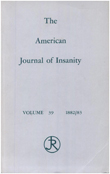Negative symptoms in schizophrenia: a confirmatory factor analysis of competing models
Abstract
OBJECTIVE: The aim of the study was to examine different models of the factor structure of negative symptoms in schizophrenia through the use of a confirmatory factor analysis procedure. METHOD: The cohort comprised 253 inpatients diagnosed with schizophrenia according to DSM- III-R criteria. Negative symptoms were evaluated with the Scale for the Assessment of Negative Symptoms (SANS). Seven alternative models of negative symptoms were compared by means of confirmatory factor analysis. RESULTS: The unidimensional model fit the data modestly. More complex multifactorial models fit the data better than simpler models. Both five-dimension models corresponding to the original SANS structure fit the data quite well; the model excluding inappropriate affect from the SANS was the best adjusted. CONCLUSIONS: Multidimensional models fit the data better than the unidimensional model. The data provide evidence for the factorial validity of the SANS and the characterization of the SANS subscales as true underlying dimensions of observable negative symptoms.
Access content
To read the fulltext, please use one of the options below to sign in or purchase access.- Personal login
- Institutional Login
- Sign in via OpenAthens
- Register for access
-
Please login/register if you wish to pair your device and check access availability.
Not a subscriber?
PsychiatryOnline subscription options offer access to the DSM-5 library, books, journals, CME, and patient resources. This all-in-one virtual library provides psychiatrists and mental health professionals with key resources for diagnosis, treatment, research, and professional development.
Need more help? PsychiatryOnline Customer Service may be reached by emailing [email protected] or by calling 800-368-5777 (in the U.S.) or 703-907-7322 (outside the U.S.).



